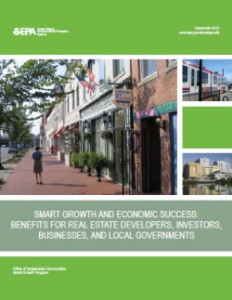 Smart Growth and Economic Success (download the PDF here) is a new report from EPA’s Smart Growth Program designed to inform developers, businesses, local government, and other groups about the economic advantages of smart growth development. As this report shows, smart growth development undefined compact, walkable, and diverse undefined is attractive to developers, investors, local governments, and communities because it offers new opportunities for economic growth that is also environmentally sustainable:
Smart Growth and Economic Success (download the PDF here) is a new report from EPA’s Smart Growth Program designed to inform developers, businesses, local government, and other groups about the economic advantages of smart growth development. As this report shows, smart growth development undefined compact, walkable, and diverse undefined is attractive to developers, investors, local governments, and communities because it offers new opportunities for economic growth that is also environmentally sustainable:
- Compact: Using land and resources more efficiently and redeveloping old or neglected areas while retaining existing infrastructure can create economic advantages for real estate developers and investors, businesses, and local governments. Compact development can generate more revenue per acre because it uses land more efficiently. It can reduce the costs of land and infrastructure for individual projects and the costs of providing fire and police protection, utilities, schools, and other public amenities. By locating companies closer together, compact development can create a density of employment that increases economic productivity and attracts additional investment.
- Walkable: Walkable neighborhoods have well-connected streets and a mix of land uses near each other, making walking and bicycling more convenient and appealing. Projects in walkable neighborhoods command a price premium, earning real estate developers and investors a higher return on investment. Improvements to streets and sidewalks can help local businesses by attracting more customers. Local governments benefit from additional property and sales tax revenue.
- Diverse: People and businesses value places that bring together a variety of activities to create vibrant environments. The demand for such places exceeds the supply. Many baby boomers and their children are particularly interested in lively neighborhoods with services to meet their daily needs close by. Communities with access to transit also help people reduce their transportation costs.
Smart Growth and Economic Success is the first in a series. Additional reports will explore how real estate developers and investors can overcome real and perceived barriers to infill, how decisions about where to locate will impact the bottom lines of businesses, and why smart growth strategies are good fiscal policy for local governments.

